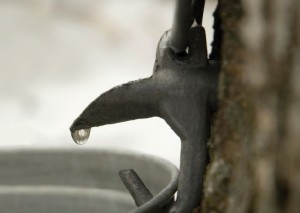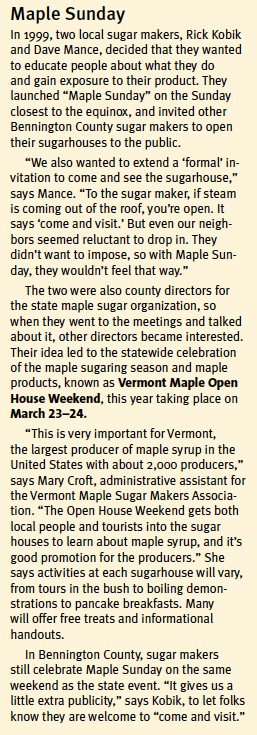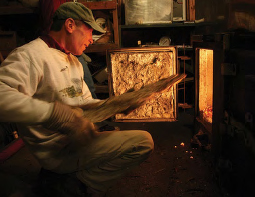With Vermont’s Maple open house weekend approaching on March 23/24th it seems prudent to offer our non-native visitors, and sheltered locals, a brief guide to maple syrup. You see, some Vermonters are born with pure syrup running through their veins, the result of generations, upon generations, of rugged mountain folk inhaling sugared steam, huddling over glowing evaporators, and toasting their success with the occasional frosty beverage. Unfortunately, I am not one of those blessed souls; rather, I am a first generation sugar maker, one who has asked all of the silly questions, and made all of the foolish mistakes. And I’m happy to share the results of those mistakes with you.
First, and foremost, brands such as Aunt Jemima and Log Cabin are not pure maple syrup. Check the ingredient list on the label. It should be nice and short, listing only pure maple syrup, any mention of “corn sugar”, high fructose anything or an indecipherable matrix of rare earth elements would cause a real Vermonter to shudder, and should steer you to a local sugar house.
Finished syrup does not flow directly from maple trees. Trees produce raw maple sap which must be concentrated to become maple syrup. These trees must be tapped to access their sweet sap and, if done correctly, it does not hurt the trees. The actual tapping of the trees is purely a matter of timing; you see trees don’t produce the correct type, or quantity, of sap year round. For syrup production maple trees must be tapped during a period of freeze and thaw cycles. This happens twice a year in Vermont, spring and fall, and you can make syrup during both seasons, but spring has proven to be more productive. Harvesting sap during both seasons doesn’t allow the trees to heal fully and, we all know that fall is hunting season in Vermont, and one must prioritize. Sap flows from the trees, either into buckets, or through a maze of plastic pipelines, straight from the tree. At this stage, it contains only about 2% sugar.To be called pure maple syrup the sugar content must be brought up to 66%. To increase the sugar content the excess water must be removed from the sap. It usually takes about 42 gallons of sap to make one gallon of pure maple syrup. Occasionally, if the maple sap is running with low sugar, it takes much more, upwards of 60 or 70 gallons. Despite years of study, loud cussing does not seem to cause an uptick in the sugar content.
Every sugar maker has a sugar bush. This isn’t a magical bush that sugar makers worship, and, in fact, it isn’t a bush at all. When talking about a sugar bush, a sugar maker is referring to an orchard of maple trees from which they collect their raw sap. Some sugar houses are lucky enough to be located where all of the sap flows directly to the sugarhouse, others require delivery, usually in the form of a large tank housed in the back of a large truck.
 The large amount of effort required in collecting raw sap, combined with traditional Yankee thrift means that if a tree within a short walk of the sugarhouse isn’t tapped, it isn’t a maple, or it isn’t large enough to sustainably tap.
The large amount of effort required in collecting raw sap, combined with traditional Yankee thrift means that if a tree within a short walk of the sugarhouse isn’t tapped, it isn’t a maple, or it isn’t large enough to sustainably tap.
There are several different types of maple, and they can all be tapped to produce maple syrup, though with varying degrees of success. This list includes sugar maple (sometimes called hard or rock maple), red maple (often called soft maple), silver maple, and even box elder. The sap from silver maple and box elder has very low sugar content, often below 1%, so these are usually skipped over by producers. The tapping of red maple digs at the heart of a great controversy in the industry. Some producers tap them with great success, others would rather sell their truck with both their spouse and favorite dog in the front seat then be caught dead tapping a red maple. The science suggests that red maple can be just as productive as sugar maple, though for a slightly shorter season.
Once sap arrives at the sugarhouse it begins a rather extensive transformation into the syrup that we love. The raw sap flows directly into a maple evaporator which is truly a showpiece in most sugarhouses—the gleaming stainless steel, the carefully crafted design, and its never ending desire for more fuel…it’s the maple equivalent of a classic 400 horsepower muscle car. An evaporator running at full boil is a thing of beauty; it is also hot, very hot. Standing too close to a traditional wood fired evaporator has led to many unexpected glowing red faces in February. It should also be noted, while it seems obvious, that metal heats up faster than denim, so while you’re warming your derriere near the evaporator you should also realize that any other waist height metal items such as buttons or zippers will be absorbing that heat at a very fast rate until they reach a near nuclear hotness. This is the point where you usually realize the error of your ways and begin dancing a sugar maker’s jig, shoving snow down your pants, and then, minutes later, trying to explain the large wet spot to the new people streaming into the sugarhouse.
When the raw sap has been processed to 66% sugar, it is finally ready for filtering and bottling. In its final form syrup can be different colors, and have different degrees of maple flavor.
 Light syrup does not have fewer calories than dark syrup, and dark syrup isn’t physically thicker than light syrup. Syrup is graded according to light transmittance and flavor, not a reflection of quality. The lightest in color and flavor is generally called light amber (“fancy” in Vermont), then on to medium amber, dark amber and grade B. Unfortunately, Mother Nature controls ninety percent of the factors that determine syrup color, and quality. As much as we’d love to make light syrup for your hyperactive niece, and dark syrup for your brother, we can’t do both at the same time, and we can’t do either at our discretion.
Light syrup does not have fewer calories than dark syrup, and dark syrup isn’t physically thicker than light syrup. Syrup is graded according to light transmittance and flavor, not a reflection of quality. The lightest in color and flavor is generally called light amber (“fancy” in Vermont), then on to medium amber, dark amber and grade B. Unfortunately, Mother Nature controls ninety percent of the factors that determine syrup color, and quality. As much as we’d love to make light syrup for your hyperactive niece, and dark syrup for your brother, we can’t do both at the same time, and we can’t do either at our discretion.
If you are making your first trip to a sugarhouse you should buy a smattering of each available grade and decide exactly which you like best. Just as I like a heavy smoke flavor on my bacon, I like a heavy maple flavor in my syrup, which translates to a grade B gracing the door of our refrigerator, where it sits next to my wife’s medium amber. Unlike cane sugar, or corn sugar, production of maple syrup is still very much a local operation, with local flavor, and made by local characters.
The Maple Open House Weekend throws open the doors of Vermont’s sugarhouses to any who would like to visit, buy syrup, or just learn more about the process. It is a great weekend for a family trip, a local adventure, or even a statewide tour. You will meet some real Vermont characters, and have a chance to sample some very fresh pure maple syrup. Now armed with the basics, I hope to see you out there. For more information please check vermontmaple.org ◊
Michael Gardner is a financial consultant most of the year, but in the spring you’ll find him in his sugarhouse in Bennington.


